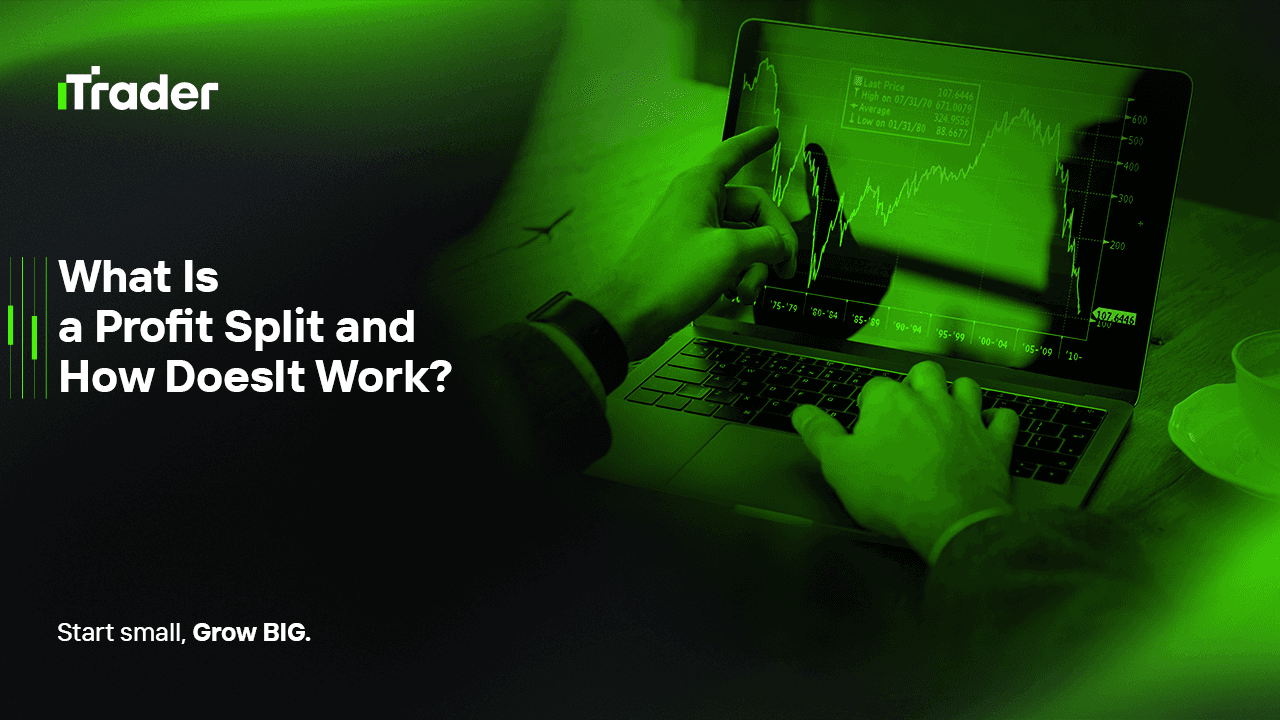2025-06-02
Whether you're new to trading or exploring opportunities with proprietary trading firms (commonly called “prop firms”), you've likely heard the term “profit split.” For many aspiring traders, prop firms offer a unique path: trade with firm capital instead of your own money and keep a portion of the profits.

But how exactly does that work? What does “profit split” mean in practice, and what should you look for in a profit-sharing agreement?
In this complete beginner’s guide, we’ll explore:
By the end, you'll have a strong understanding of this key trading concept and how to take advantage of it.
A profit split is an agreement between two parties—usually a trader and a prop trading firm—that outlines how net profits will be divided after a trading period. This usually happens when a trader uses capital provided by the firm to trade financial markets, such as forex, stocks, commodities, or crypto.
Since the firm is putting up the money and taking the risk, they’re entitled to a share of the profits. On the other hand, the trader is providing the skill, strategy, and labor—so they also deserve compensation for good performance.
Profit splits can vary, but they’re always stated as a percentage, such as:
These splits are agreed upon before trading begins and are enforced during each payout cycle, whether weekly, monthly, or at a certain milestone.
Let’s say you join a prop trading firm and successfully pass their evaluation or challenge. The firm gives you access to a funded trading account (for example, $100,000).
At the end of a profitable month, here’s how the profit split works.
Breakdown:
Breakdown:
The firm usually covers any trading losses, not the trader, unless the trader violates the account's risk management rules (like a daily drawdown limit).
Prop trading firms make money by recruiting skilled traders who can consistently generate profits. Since the firm’s capital is at risk, profit-sharing allows them to:
The trader, in return, gains:
It's a win-win relationship when done right.
To fully benefit from a profit split, traders must understand how markets move. Most trends go through four distinct phases, which directly affect a trader’s ability to generate profits.
The key takeaway: Traders who identify trends early (during Accumulation or early Markup) have the best shot at maximizing profit splits.
Different firms offer different profit splits based on their business models. Here are some typical structures:
50/50 Equal share – common for new traders or entry-level programs
70/30 Trader keeps 70% – mid-level or scaling phase
80/20 Trader keeps 80% – standard for most funded accounts
90/10 Premium split – typically for advanced or high-performing traders
100/0 Rare – may be offered temporarily as an incentive or during promotions
Some firms offer scaling profit splits, where traders can increase their share as they hit targets or prove consistency over time.
Once the profit split is calculated, most firms will process payouts on a weekly or monthly basis. Payout methods include:
Most firms also set minimum payout thresholds (e.g., $100), and require that no trading rules were violated during the payout period.
Keep in mind:
Always read the payout policy before committing.
Before joining a funded program or prop firm, review the profit split terms carefully. Here are the key factors to consider:
Profit splits offer many advantages, especially for new or capital-limited traders.
Profit splits aren't all upside. Be aware of these challenges:
If you're looking to make the most out of your agreement, follow these tips:
.
Profit splits are a powerful way to grow as a trader—especially if you're skilled but underfunded. They create a pathway to trade large accounts, earn high income, and build experience in a professional setting.
But success in a profit split model requires more than just talent. It requires discipline, patience, rule-following, and emotional control.
If you're ready to treat trading like a business and can commit to consistent performance, joining a prop firm with a fair profit split could be one of the best financial decisions you make.
2025 Ай Трейдер Глобал ХХК | Компанийн бүртгэлийн дугаар: 15962
Ай Трейдер Глобал ХХК нь Комор улсын Анжуан арал дахь Мутсамуду хотын Хамчакод байрлалтай. Тус компани нь Коморын Үнэт Цаасны Хорооноос (Securities Commission of the Comoros) олгосон L15962/ITGL дугаартай тусгай зөвшөөрлийн хүрээнд үйл ажиллагаа явуулдаг.
Ай Трейдер Глобал ХХК нь “iTrader” нэрийн дор үйл ажиллагаа явуулдаг бөгөөд (Форекс) арилжааны үйл ажиллагаа явуулах эрхтэй. Компанийн лого, барааны тэмдэг, вэбсайт нь зөвхөн Ай Трейдер Глобал ХХК компанийн өмч юм.
Ай Трейдер Глобал ХХК -ийн охин компани болох : iTrader Global Pty Ltd, Австралийн компанийн бүртгэлийн дугаар (ACN): 686 857 198. Энэ компани нь Opheleo Holdings Pty Ltd компанийн албан ёсны төлөөлөгч бөгөөд Австралийн санхүүгийн үйлчилгээний төлөөлөгчийн дугаар: 001315037 -тай. Австралийн санхүүгийн үйлчилгээний лицензийн дугаар: 000224485 -тай Level 1, 256 Rundle St, Adelaide, SA 5000 хаягт байршдаг. Анхааруулга: Энэ байгууллага нь энэхүү вэбсайт дээр болон дамжуулан арилжаалагдаж буй санхүүгийн (арилжааны) хэрэгсэл нийлүүлэгч биш бөгөөд ямар нэгэн хариуцлага хүлээхгүй болно.
Эрсдэлийн сэрэмжлүүлэг: CFD арилжааны хөшүүргийн улмаас хөрөнгөө хурдан алдах өндөр эрсдэлтэй тул бүх хэрэглэгчдэд тохиромжгүй байдаг.
Фанд, CFD болон бусад өндөр xөшүүрэгтэй арилжаа нь хэрэглэгчээс нарийн төвөгтэй ойлголтуудын талаар тусгай мэдлэг шаарддаг. Хөшүүрэгтэй арилжаанд оролцогчдын 84.01% нь алдагдал хүлээдгийг судалгаанууд харуулдаг тул хөшүүрэгтэй арилжаанд орохоос өмнө хөрөнгөө алдах маш өндөр эрсдэлтэй болохыг анхаарна уу.
iTrader нь аливаа иргэн, хуулийн этгээдийн өмнө xөшүүрэгтэй арилжааны эрсдэл, алдагдал, бусад хохирлыг бүхэлд нь хариуцахгүй болохыг мэдэгдэж байна.
Энэхүү веб сайтын мэдээ, мэдээлэл нь зөвхөн мэдлэг түгээх зорилготой тул хэрэглэгч та бие даан шийдвэр гаргана уу.
Хязгаарлалт: iTrader нь вэбсайт болон үйлчилгээгээ тухайн орны хууль тогтоомж, дүрэм журмаар хориглосон орнуудад оршин суугчдад чиглүүлдэггүй. Хэрэв та энэхүү вэбсайтыг ашиглахыг хориглосон оронд байгаа бол вэбсайт болон үйлчилгээг ашиглахдаа тухайн орны хууль тогтоомжид нийцэж байгаа эсэхийг шалгах үүрэгтэй. iTrader нь вэбсайтынхаа мэдээлэл бүх оронд тохиромжтой эсэхийг баталгаажуулдаггүй.
Ай Трейдер Глобал ХХК нь зарим улс орны иргэдэд үйлчилгээ үзүүлэхээс татгалздаг болно. Жишээлбэл: АНУ, Орос, Бразил, Канада, Израйл, Иран.